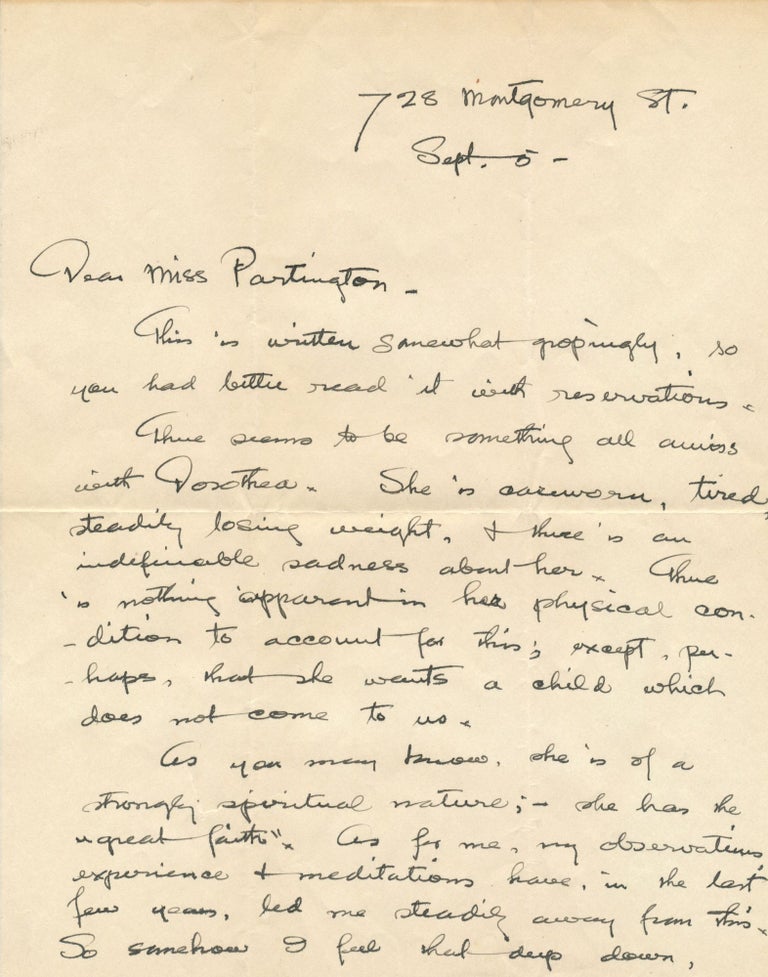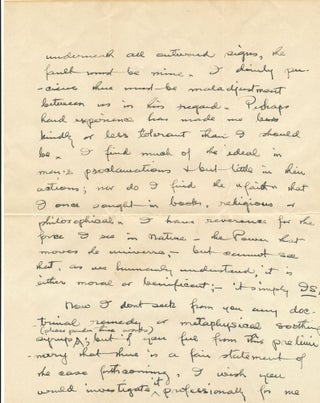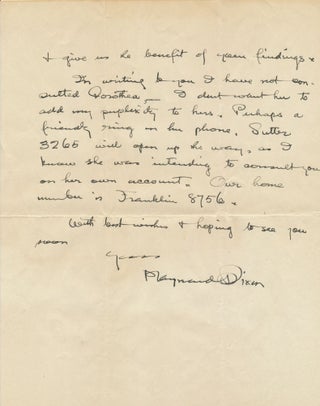MAYNARD DIXON, Dorothea Lange
DIXON, MAYNARD Scarce Autograph Letter SIGNED about DOROTHEA LANGE.
Autograph Letter Signed. Dixon writes about his wife, photographer Dorothea Lange (1895-1965). Lange is best known for her iconic images of Depression era rural poverty in America. Dixon and Lange married in 1920 and divorced in 1935. Lange established herself as a photographer during the course of their rocky marriage. At the end of 1935, Lange married economist Paul Taylor. Here, Dixon worries about Lange and seeks insight from Blanche Partington, a local Christian Science practitioner in San Francisco where Dixon and Lange lived. The letter suggests that Partington was some sort of spiritual counselor.
Dixon apologizes for writing “somewhat gropingly, so you had better read it with reservations. There seems to be something all amiss with Dorothea. She is casework, tired, steadily losing weight, and there’s an indefinable sadness about her….” Dixon surmises that Lange’s desire for a child may account for her “sadness”. He describes their different dispositions. “…she is of a strongly spiritual nature; she has the ‘great faith.’…my observations, experience and meditations have…led me steadily away from this. So somehow I feel that deep down, underneath all outward signs, the fault must be mine. I daily perceive there must be maladjustment between us in this regard. Perhaps hard experience has made me less kindly or less tolerant than I should be….”
Dixon writes about his own philosophic changes. “I find much of the ideal in men’s proclamations & but little in their actions; nor do I find the ‘faith’ that I once sought in books, religious or philosophical. I have reverence for the force I see in nature – the Power that moves the universe, - but cannot see that as we humanly understand, it is either moral or beneficent – it simply IS….” He makes clear that he does not seek advice about how to understand or cope with Lange, but asks that Partington “would investigate it professionally for me” if she thinks his presentation “is a fair statement.” Dixon ends the letter noting confidentiality. “In writing to you I have not consulted Dorothea – I don’t want her to add my perplexity to hers…she was intending to consult you on her own account….” Dixon offers two phone numbers and signs in full, “Maynard Dixon.”.
The conflict within Lange during the early years of their marriage may also have been a reaction to Dixon’s “difficult” ten-year old daughter who came to live with them shortly after they were married. During the first few years of their marriage, Dixon’s work blossomed while Lange looked after the house and their now three-person family. She was trying to be a working woman in a world not yet ready for such things with a man not quite understanding of her needs as he somewhat realizes in this letter. He left all care of Constance Dixon, his daughter known as Consie and household responsibility to Lange who was, in actuality, the breadwinner for the family.
Consie was an abused product of divorced parents, with a mother who suffered from either alcoholism or mental illness, or perhaps both. Consie treated Lange very badly, demanding her attention while she was trying to work and run the house. [Much of this information above and below from “Dorothea Lange: A Life Beyond,” by Linda Gordon].
Lange began to resent Dixon’s lengthy traveling, leaving her without consulting her. Apparently, he cheated on her while away. Whether this bothered Lange or not is hard to say as some sources claim that it was part of the reason their marriage sustained fifteen years. [source in bh history] (2012 – in which Dorothea Lange attempts matrimony – by Ellen Copperfield]
In 1922, the year Dixon likely penned this letter, (and again for a time in 1923), Consie was “placed out” as it was called then for four months while Lange and Dixon stayed on a Navajo reservation in Arizona. It is reasonable to suggest that this letter could have been written before Lange and Dixon went on their four-month journey to Arizona, escaping the stresses of looking after Consie and the house while building a career. It does not appear that as Dixon says in this letter, Lange was unhappy at not having a child of her own. She was consciously on birth control for the first five years of her marriage until she decided to have a child. Daniel was born in 1925.
Our letter offers insight into the personal lives of two important twentieth century artists during the time they were husband and wife.
Item #4425
Price: $2,900.00


